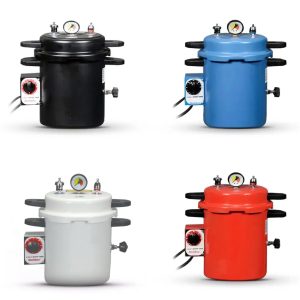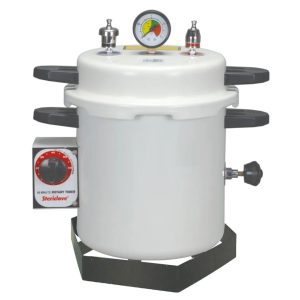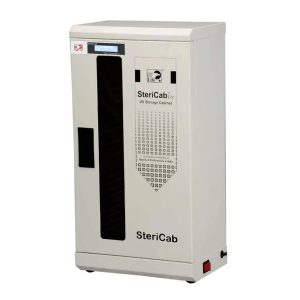-
Life Steriware Premium Colour...
14 litre top loading autoclaves with free drum
-
Life Stericab Ultra Violet (U...
Life Ultraviolet Storage Cabinet with Magnetic gasket on the door that seals the chamber.
-
Life Steriware Dental Autocla...
Stylish, Light, Compact, Portable, Easy to use top loading Autoclaves
-
Life Stericab Ultra Violet (U...
Life Ultraviolet Storage Cabinet with Intensity Meter
Dental Sterilization
In dental health care settings, all instrument cleaning, disinfecting, and sterilizing should occur in a designated central processing area in order to more easily control quality and ensure safety. Before sterilization, the Equipments and machines should be cleaned to make sure they are free any kind of dust and debris on their surface. If visible debris is not removed, it will interfere with microbial inactivation and can compromise the disinfection or sterilization process.
Dental items are categorized depending on the potential risk for transmission of infection associated with their intended use:
- ” Critical” items penetrate soft tissue or bone and have the highest risk of transmitting infections; these items should always be heat sterilized. Examples: surgical instruments and periodontal scalers.
- ” Semi-critical” items touch mucous membranes and have a lower risk of transmission than critical items. Most semi-critical items can be heat sterilized. If they cannot tolerate heat sterilization, they should be processed using a high-level sterilizer. Examples: mouth mirrors, amalgam condensers, and reusable impression trays.
NOTE: If a semi-critical item is heat-sensitive, DHCP should replace it with a heat-tolerant or disposable alternative. If none are available, the item should, at a minimum, be processed using high-level disinfection.
- “Non-critical” items only contact skin and have the lowest risk of transmission. In most cases, noncritical items can be cleaned and low level disinfected. Examples: x-ray head or cone, face bows, blood pressure cuff.
- Single-Use (Disposable) Devices- Intended for use on one patient during a single procedure. Usually not heat-tolerant. Cannot be reliably cleaned. Do NOT reprocess. Examples: syringe needles, prophylaxis cups, and plastic orthodontic brackets.
By using quality sterilization equipment, the dentist can greatly reduce the risk of disease transmission. Proper dental sterilization is not only a benefit to the health of others but also the longevity of the dental instrument itself.
Cleaning should always occur before disinfection or sterilization. – Presence of soil can compromise the disinfection or sterilization process. Wear personal protective equipment (e.g., heavy duty utility gloves, mask, protective eyewear and clothing) to minimize exposure.
Dental sterilizer– dental autoclave is steam sterilizer that is used to sterilize and properly sanitize dental Equipments after their use. It utilizes high-pressure temperatures and steam to combat debris and bacteria. It meets the CDC requirements for proper sterilization and allows dentist offices to reuse a variety of their instruments and tools. While there are a number of these available in the market, here are some top-rated autoclaves in dentistry that are commonly used at reputable dentist offices across the country.
- APHRODITE Steam Autoclave Sterilizer- it is liked by dental professionals because of its sheer size and heating options. Besides storing more items inside it, it also ensures a control mechanism for quality cleaning.
- All-American Electric Sterilizer- it is known due to its durability. It is time. It also has easy-to-use control valves, which allows the user to better control the sanitization process.
- Tuttnauer EZ10P Fully Automatic Autoclave- this dental sterilizer can clean both wrapped and unwrapped instruments, which means an easier process for the user. Additionally, the locking mechanism ensures that the machine does not open during the sterilization process.
Apart from autoclaving, other methods are:
- Dry heat
- Unsaturated chemical vapor
There are many liquid sterilizers or disinfectants. But they are only used for heat-sensitive critical and semi-critical devices because of their toxicity. Manufacturer’s instructions should be read carefully before using these sterilizers. Besides, heat tolerant or disposable alternatives are also available.
Storage of Sterile and Clean Items and Supplies
Store clean items in dry, closed, or covered cabinet.
Use date- or event-related shelf-life practices.
Examine wrapped items carefully before use.
When packaging of sterile items is damaged, clean, repackage, and heat sterilize again.
Q.) WHY YOU SHOULD BUY DENTAL STERILIZING MATERIALS AND EQUIPMENTS FROM DENTALSTALL.COM?
dentalstall.com offers a wide range of products that dentists can go through before buying products for their patients. we have best quality products from all major renowned brands. dentalstall.com believes in customer satisfaction as its priority. this strategy makes us deliver the best product at the best prices conveniently at your destination. we hear all your product-related queries patiently and our team will strive to satisfy our valuable customers. some renowned brands are- oro, denmax, mixpac, indian, chineese, dentsply etc.




